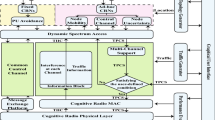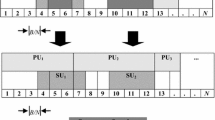Abstract
Recent studies to improve the spectrum utilization and efficiency show that Dynamic Spectrum Access and Cognitive Radio are the two techniques to satisfy these requirements. The use of such techniques will overcome the inefficient spectrum utilization due to fixed frequency allocation techniques. To enable the Secondary Users to coexist with the Primary Users, Overlay and Underlay are the two transmission techniques that are widely used. In this paper, we present a hybrid overlay/underlay spectrum access strategy that has the features of both the traditional overlay and underlay strategies. This strategy presents a novel approach in which the primary users can use the secondary users to maximize their throughput. In addition to the hybrid overlay/underlay transmission strategy, this paper also provides a resource allocation protocol that decides the best secondary user to be selected as relay, power levels of these secondary users and best channel to be selected. Unlike the previous works done on hybrid transmission protocols, where the main aim is to maximize the secondary user throughput, this paper aims to maximization of primary user capacity and avoiding harmful interference to other active primary users and avoids the need to switch between the overlay and underlay protocols. Performance analysis is done with simulations of hybrid overlay/underlay, underlay and overlay techniques and discussions on results are presented. Discussions are also provided on the criterion for relay power selection between interference only constraint and power only constraint.







Similar content being viewed by others
References
Mitola, J., & Maguire, G. Q. (1999). Cognitive radio: making software radios more personal. IEEE Personal Communications, 6, 13–18.
F. C. Commission. (2002). Spectrum policy task force. Rep. ET docket no. 02-135, Nov. 2002.
Srinivasa, S., & Jafar, S. (2007). Cognitive radios for dynamic spectrum access—The throughput potential of cognitive radio: A theoretical perspective. IEEE Communications Magazine, 45, 73–79.
Xia, M., & Aissa, S. (2013). Underlay cooperative af relaying in cellular networks: performance and challenges. IEEE Communications Magazine, 51, 170–176.
Lu, L., Zhou, X., Onunkwo, U., & Li, G. (2012). Ten years of research in spectrum sensing and sharing in cognitive radio. EURASIP Journal on Wireless Communications and Networking, 2012, 28.
Akyildiz, I. F., Lee, W.-Y., Vuran, M. C., & Mohanty, S. (2006). NeXt generation/dynamic spectrum access/cognitive radio wireless networks: A survey. Computer Networks, 50, 2127–2159.
Jia, J., Zhang, J., & Zhang, Q. (2009). Cooperative relay for cognitive radio networks. In INFOCOM 2009 (pp. 2304–2312). Rio de Janeiro: IEEE.
Su, W., Matyjas, J. D., & Batalama, S. (2012). Active cooperation between primary users and cognitive radio users in heterogeneous Ad-Hoc networks. IEEE Transactions on Signal Processing, 60, 1796–1805.
Senthuran, S., Anpalagan, A., & Das, O. (2012). Throughput analysis of opportunistic access strategies in hybrid underlay–overlay cognitive radio networks. IEEE Transactions on Wireless Communications, 11, 2024–2035.
Zou, J., Xiong, H., Wang, D., & Chen, C. W. (2013). Optimal power allocation for hybrid overlay/underlay spectrum sharing in multiband cognitive radio networks. IEEE Transactions on Vehicular Technology, 62, 1827–1837.
Song, H., Hong, J.-P., & Choi, W. (2013). On the optimal switching probability for a hybrid cognitive radio system. IEEE Transactions on Wireless Communications, 12, 1594–1605.
Usman, M., & Koo, I. (2014). Access strategy for hybrid underlay–overlay cognitive radios with energy harvesting. IEEE Sensors Journal, 14, 3164–3173.
Tan, X., Zhang, H., & Hu, J. (2013). Achievable transmission rate of the secondary user in cognitive radio networks with hybrid spectrum access strategy. IEEE Communications Letters, 17, 2088–2091.
Wang, Y., Ren, P., Gao, F., & Su, Z. (2014). A hybrid underlay/overlay transmission mode for cognitive radio networks with statistical quality-of-service provisioning. IEEE Transactions on Wireless Communications, 13, 1482–1498.
Bletsas, A., Shin, H., & Win, M. (2007). Cooperative communications with outage-optimal opportunistic relaying. IEEE Transactions on Wireless Communications, 6, 3450–3460.
Prasad, M. S. G., Siddaiah, P., & Reddy, L. P. (2009). Analysis of different direction of arrival (DOA) estimation techniques using smart antenna in wireless communications. In Proceedings of the International Conference on Advances in Computing, Communication and Control, ICAC3'09 (p. 639).
Bansal, G., Hossain, M., & Bhargava, V. (2008). Optimal and suboptimal power allocation schemes for OFDM-based cognitive radio systems. IEEE Transactions on Wireless Communications, 7, 4710–4718.
Preetham, C. S., & Prasad, M. S. G. (2015). Relay, power and subchannel allocations for underlay non LOS OFDM-based cognitive networks under interference temperature. In Signal processing and communication engineering systems (SPACES), 2015 International Conference on, Guntur, 2015, pp. 205–209.
Shaat, M., & Bader, F. (2012). Asymptotically optimal resource allocation in OFDM-based cognitive networks with multiple relays. IEEE Transactions on Wireless Communications, 11, 892–897.
Chen, K. C., & Prasad, R. (2009). Cognitive radio networks. London: Wiley.
Author information
Authors and Affiliations
Corresponding author
Rights and permissions
About this article
Cite this article
Preetham, C.S., Prasad, M.S.G. Hybrid Overlay/Underlay Transmission Scheme with Optimal Resource Allocation for Primary User Throughput Maximization in Cooperative Cognitive Radio Networks. Wireless Pers Commun 91, 1123–1136 (2016). https://doi.org/10.1007/s11277-016-3516-1
Published:
Issue Date:
DOI: https://doi.org/10.1007/s11277-016-3516-1




